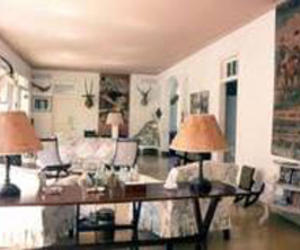Vigia Farm: Against Time and other Demons
- Submitted by: manso
- Arts and Culture
- 10 / 18 / 2010

Almost hidden, maybe fearful of the scratch of an untimely visitor, the Vigia Farm still surprises those that visit the home, found among exuberant pines, mangos and palm trees that shaded, for over two decades, US writer Ernest Hemingway.
Once inside, those that discover the belongings of the author of the “Old Man and the Sea”, the pool where Ava Gardner swam, the yacht that experienced so many adventures at sea or the tower with the view of the hills of San Francisco de Paula remain a part of the conserved history of the current Hemingway Museum, sanctuary of the God of Bronze of US literature.
The home, which was founded in 1962, of the renowned US novelist provoked mystic and tempting effects. Although there are some of its furniture and other treasures that need some restoration, it is encouraging to learn on the actions that the Cuban National Council of Cultural Heritage assumes to show the public the bungalow, garage and other places of the house, today turned into working offices.
Since November of 2002, the National Council of Cultural Heritage and the US NGO- Research Council of Social Sciences, responded to the request of the Hemingway Museum in the signing of an agreement to recovery and digitalize over 11 000 letters, pamphlets and books, which also included the refurbishing of some of the furniture.
Ada Rosa Alfonso, current director of the house-museum, admitted that US specialists facilitated the recovery of the original chromatic tones of the vessel and the home with lab research, but Washington limited the institution’s personnel to remain on the island for only three days, something which they opposed but had to comply with.
The agreement allowed for the digital material go to the John F. Kennedy Library while the capital reparation of the home, tower and “Pilar” yacht was completely financed by Cuba.
Early this year, a continuation agreement was signed by Margarita Ruiz, President of the National Council of Cultural Heritage and the US Vigia Farm Foundation, but the Cuban government assumes the total cost which is, up until now, some 3.5 million pesos.
Surrounding the farm you can already see the new constructions destined for the offices and the rehabilitation documents workshop, although it would be necessary for the United States to stop placing obstacles for those that wish to contribute with materials aimed at restoring very valuable books from the creator of “Farewell to the Arms” and other figures linked to him, like Maxwell Perkins.
Margarita Elorza, specialist of the National Council of Cultural Heritage affirms that this year some materials for the workshop estimated at 50 000 dollars will be imported from Italy only if the renowned brand Gaylord of US patent can execute the sale.
Without a doubt, large numbers of people from the US that visit the Museum are victims of Washington’s arbitrations; as many others, interested in the life of Hemingway and are prohibited from participating in the International Hemingway Colloquium held every two years in Havana, said Ada Roda Alfonso.
The director’s demand goes beyond: she requests the US government to allow, at least the purchase of reproductions of art work by Juan Gris, Waldo Pierce and Paul Klee who once decorated the insides of the residence. Mary Welsh, widow of Hemingway took the originals with her when departing from Cuba.
The truth is that in order to preserve the home, where Hemingway’s presence if still felt, should not only be an issue between governments and states, but of the interests of the peoples.
By Lazaro J. Gonzalez Gonzalez
Source: ACN
Comments